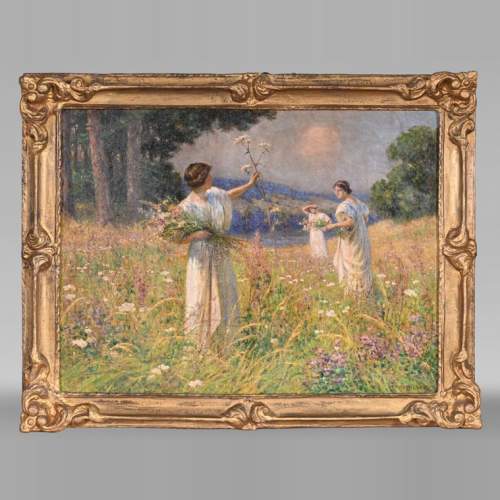Style Other / Ref.12965
CHOCQUEEL HOUSE, Aubusson tapestry "The Fortune Teller" or "The Bohemian" from a model by J.B. Leprince, Late 1860s
Dimensions
Width 131'' ⅞ 335cm
Height 123'' ⅝ 314cm
Origin:
France, 19th century
Status:
Contact us for condition report
This tapestry was made by Chocqueel in the late 1860s. It is based on the design of a tapestry woven by the Beauvais manufacture in 1782 from a cartoon by the painter Jean-Baptiste Leprince.
W. Chocqueel House was founded in 1831. At the time, it bore the names of three partners: Requillard, Roussel and Chocqueel. Its tapestry workshops were located in Tourcoing and Aubusson, and it had sales outlets in Lille and Paris. The company took part in the major exhibitions of the second half of the nineteenth century, winning numerous medals. It also became a patented supplier to the Emperor and Empress, as well as to the Queen of England, from 1860. Its director, Winoc Chocqueel (1812-1871), was made a Knight of the Légion d'Honneur in 1862 and the following year published an essay on the history and current situation of the tapestry and carpet industry.
His high-quality creations "can rival those of Aubusson, Beauvais and the Gobelins" (La Vie Parisienne, January 1873) were praised by the Gazette des Beaux-Arts published in 1870: "Visit the shops for a while [...] and you'll come back amazed like me. M. Chocqueel has made door curtains and hangings for the Duke of Westminster in his Tourcoing factories; nothing like it has ever been seen before; besides, who doesn't know that everything bearing the stamp of the Chocqueel company has its place in sovereign and princely palaces?"
La Diseuse de bonne aventure is based on a tapestry produced in the eighteenth century by the Manufacture Nationale de la Tapisserie de Beauvais, two examples of which are now in the Louvre and the Musée Jacquemart André. The original tapestry was part of a set entitled "Les Jeux Russiens", comprising six tapestries: Le Repas, La Danse, La Chasse aux oiseaux, La Laitière, Le Joueur de Guitare and La Bohémienne. The cartoons were commissioned from the painter Jean-Baptiste Leprince (1734-1781).
The artist was a pupil of François Boucher. He was chosen because of his title as official painter to the Imperial Court of Russia, where he lived between 1757 and 1762. It was on his return to France that he introduced the fashion for russeries, which succeeded chinoiseries, with the exhibition at the Salon in 1765 of some fifteen canvases depicting Russian subjects, of which this tapestry cycle is an example.
The scene depicted here takes place in a lush forest, where a makeshift shelter has been built. In front of the tent, a middle-aged woman dressed in a rich Russian-style costume is deciphering the handwriting of a young woman accompanied by a man. On the left, a swaddled infant lies between hens and a sheep, surrounded by a variety of objects such as an amphora, a wicker basket and a cabbage. On the right, two men are working around horses.
A study made for the tapestry cartoon, now in the Musée de Picardie in Beauvais, depicts the three main characters. The richness of their clothes is highlighted by the colours and flashes of light that bring out the preciousness of the materials. The painter's choice of clothing was more aesthetic than ethnographic. There are a few differences between the tapestries in the Louvre and those in the Jacquemart André collection: in the former, the drawing is closer together, and some of the details are obscured. Our tapestry therefore appears to have been made after the model in the Musée Jacquemart André, which is identical in every respect, although in reverse.
Recommended for you :
Dimensions:
Width: 178
Height: 129
Depth: 14
Dimensions:
Width: 20
Height: 18
Dimensions:
Width: 32
Height: 41
Dimensions:
Width: 76
Height: 84
Dimensions:
Width: 43
Height: 63
Dimensions:
Width: 117
Height: 90
Depth: 8
Dimensions:
Width: 227
Height: 161
Dimensions:
Width: 71
Height: 100
Depth: 6
Dimensions:
Width: 67
Height: 95
Depth: 2
Dimensions:
Width: 77
Height: 110
Depth: 5
Dimensions:
Width: 65
Height: 195
Depth: 3














